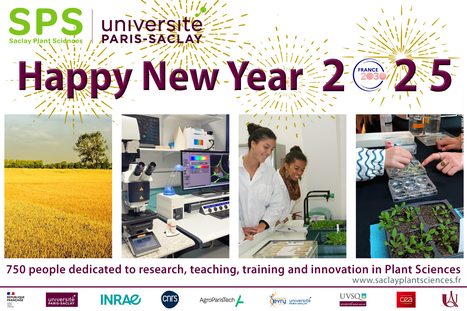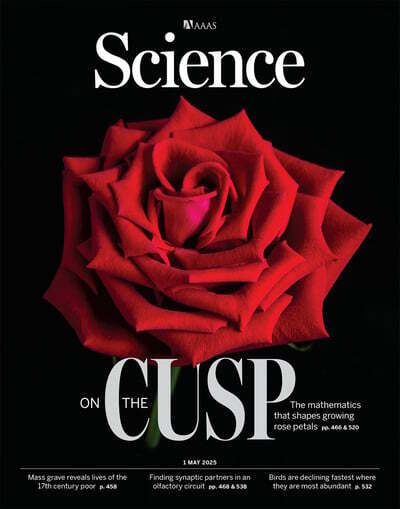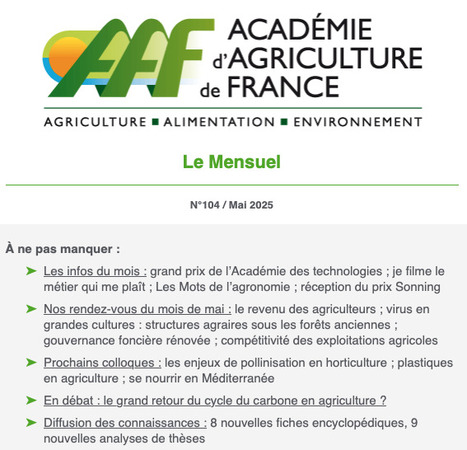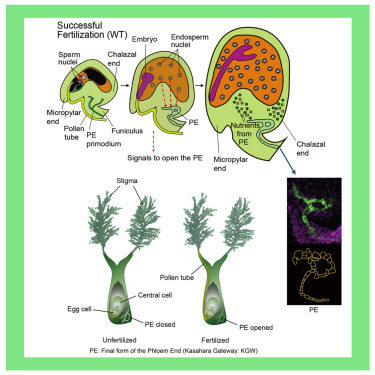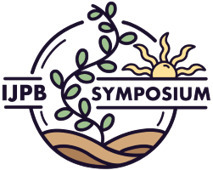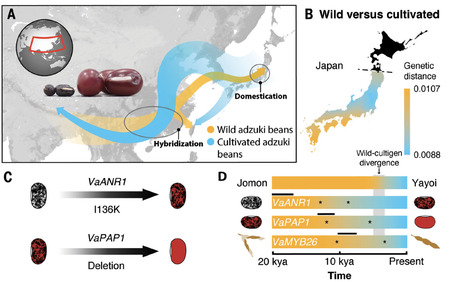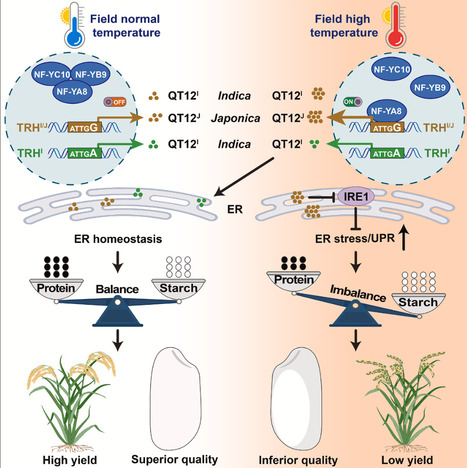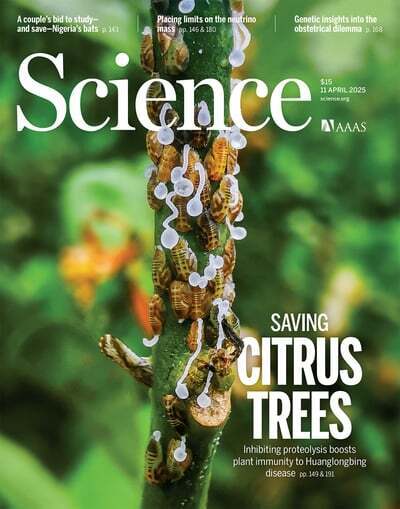 Your new post is loading...
 Your new post is loading...

|
Scooped by
Loïc Lepiniec
September 30, 8:41 AM
|
"Flavonoid metabolites dye many plant organs such as flowers, fruits, seeds, leaves or tubers. Over the past 150 years, tracking flavonoid-related colour changes in plants has shaped the foundation of many modern biology questions. This includes ground-breaking discoveries such as Gregor Mendel’s law of inheritance (using white and purple pea flowers), Barbara McClintock’s identification of transposable elements (through her research on variably coloured maize kernels) or Carolyn Napoli’s description of co-suppression (based on her observations of altered and novel flower colouration in petunia). In recent decades, the intricate, diverse and finely tuned flavonoid pathway has been unravelled and the understanding of this pathway across various plant species owes much to the characterization of mutants disrupted in the biosynthesis, transport and storage of flavonoids that similarly displayed modified flower and seed pigmentation (Winkel-Shirley 2001; Koes et al. 2005; Lepiniec et al. 2006). The model plant A. thaliana provided a wealth of such mutants (transparent testa mutants, tt) exhibiting altered seedcoat colours (Fig. 1) (Koornneef 1990; Shirley et al. 1992; Lepiniec et al. 2006). Their characterization enabled researchers to associate genes or loci with flavonoid-related functions. However, although their visual and non-lethal phenotypes were easy to identify and offered insight into the disrupted gene functions, further investigation was required to confirm these functions. Beyond colour, to fully unravel this pathway, it has become essential to individually characterize the seed flavonoids, determine their spatial and temporal distribution, and their diversity. This laid the groundwork for validating locus functions, characterizing novel gene roles, and identifying as well as quantifying flavonoid accumulation in other plants".

|
Scooped by
Loïc Lepiniec
September 20, 4:36 AM
|
Time-resolved reprogramming of single somatic cells into totipotent states during plant regeneration, https://www.cell.com/cell/fulltext/S0092-8674(25)01020-7
• LEC2 reprograms somatic epidermal cells into totipotent somatic embryo founder cells • LEC2 and SPCH co-activate local auxin biosynthesis by targeting TAA1 and YUC4 • GMC-auxin state marks stomatal cells shifting from differentiation to totipotency • Transcriptional rewiring and auxin signaling drive reprogramming of stomatal cells

|
Scooped by
Loïc Lepiniec
September 19, 11:58 AM
|
"ABA response is tightly modulated by nitrogen nutrition NRT1.1B acts as a dual receptor to competitively bind ABA and nitrate NRT1.1B-SPX4-NLP4 cascade underlies ABA signaling from the plasma membrane to the nucleus NRT1.1B integrates compound environmental cues across different species in plants"

|
Scooped by
Loïc Lepiniec
September 15, 4:30 AM
|
One of MASC’s major goals is to strengthen international cooperation. Through the combined efforts promoted by MASC, more progress in Arabidopsis research is achieved and redundancy is reduced. Since 1990, Arabidopsis researchers and representatives from community projects and resources regularly report their progress and reccommend future directions in Arabidopsis research. Since 2002 the annual Multinational Arabidopsis Steering Committee (MASC) report is compiled by MASC chairs and coordinator and published at the International Conference on Arabidopsis Research (ICAR).

|
Scooped by
Loïc Lepiniec
August 21, 7:19 AM
|
Seed development in Arabidopsis thaliana is largely controlled by a set of transcription factors (TFs) called LAFL, including LEAFY COTYLEDON 2 (LEC2). In this study, we investigated the structure/function relationships of the protein LEC2 outside the well-described B3 DNA-binding domain. The results presented here unveil the presence of transcription activation domains (ADs) within the unstructured ends of the protein that are conserved in eudicots. Expression in both yeast and moss protoplasts of deleted and mutated versions of LEC2 confirmed the transcriptional activity of these ADs. Surprisingly, the expression of LEC2 variants lacking their ADs restored a wild-type seed phenotype in lec2 mutant, showing that these ADs are not essential for LEC2 function in seed development. Moreover, ZmAFL2/ZmABI19, a maize B3 factor related to LEC2 but deprived of N-ter AD, can also complement lec2 seed phenotype and induce abnormal vegetative development when overexpressed in Arabidopsis, supporting this observation. This work suggests that LEC2 can act both as a classical transcriptional activator or without transactivation activity, probably through its interaction with the pioneer factor LEC1. Taken together, the results provide important insights into the function of the LAFL master regulators during seed development, from cell differentiation to storage accumulation in seed.

|
Rescooped by
Loïc Lepiniec
from Plant Sciences
June 1, 1:27 PM
|

|
Scooped by
Loïc Lepiniec
May 1, 4:38 PM
|
"Growth and form are deeply interconnected, in a manner often mediated by mechanical instabilities arising from geometric incompatibilities. Although Gauss incompatibility has long been recognized as the source of morphing in naturally growing slender organs, here we show that the growth profile of rose petals remains Gauss compatible. Their distinctive shape emerges from a different type of geometric incompatibility, the Mainardi-Codazzi-Peterson (MCP) incompatibility, which leads to the formation of localized cusps along the petal margins. We validated this mechanism in model disc petals theoretically, computationally, and experimentally. Our study reveals distinct morphological regimes, ranging from smooth edges to cusp-forming configurations, and demonstrates how stress focusing at cusps influences subsequent petal growth. These findings position MCP incompatibility as a generic mechanism for cusp formation in both natural and manmade self-morphing sheets."

|
Scooped by
Loïc Lepiniec
April 29, 10:46 AM
|

|
Scooped by
Loïc Lepiniec
April 16, 3:13 AM
|
"Seed formation is essential for plant propagation and food production. We present a novel mechanism for the regulation of seed size by a newly identified “gate” at the chalazal end of the ovule regulating nutrient transport into the developing seed. This gate is blocked by callose deposition in unfertilized mature ovules (closed state), but the callose is removed after central cell fertilization, allowing nutrient transport into the seed (open state). However, if fertilization fails, callose deposition persists, preventing transportation of nutrients from the funiculus. A mutant in an ovule-expressed β-1,3-glucanase gene (AtBG_ppap) showed incomplete callose degradation after fertilization and produced smaller seeds, apparently due to its partially closed state. By contrast, an AtBG_ppap overexpression line produced larger seeds due to continuous callose degradation, fully opening the gate for nutrient transport into the seed. The mechanism was also identified in rice, indicating that it potentially could be applied widely to angiosperms to increase seed size."

|
Scooped by
Loïc Lepiniec
March 6, 10:44 AM
|
Le 7 mars, mobilisons-nous pour les sciences ! En écho à Stand Up For Science aux États-Unis et face aux menaces contre les institutions scientifiques, des actions auront lieu dans chaque ville universitaire de France.

|
Rescooped by
Loïc Lepiniec
from Plant Sciences
January 2, 7:30 AM
|

|
Rescooped by
Loïc Lepiniec
from Plant and Seed Biology
December 15, 2024 4:14 AM
|
We are pleased to announce that the "Plant science in the Anthropocene" (PLANT) workshop will take place March 24th to April 4th 2025 at University Paris-Saclay. It will address key challenges from basic sciences to socio-economic and environmental issues, including climate change.
https://eng-saclay-plant-sciences.hub.inrae.fr/events/workshop-institut-pascal
The deadline for applying is December 17th.
The "PLant science in the ANThropocene" (PLANT) workshop will run from March 24 to April 4, 2025 at the Institut Pascal of the University Paris-Saclay (campus about 25 km south of Paris).
This 2-week workshop will address key challenges for the international Plant Science community, from basic sciences to socio-economic and environmental aspects including climate change. It will gather about 60 international scientists. The attendance will mix high stature senior scientists, together with numerous younger ones.
The program will focus on three themes:
- Theme I: "Frontiers in Plant Science fundamental research" (March 24-25-26)
- Theme II: “Feeding the planet: roles for Plant Science and associated socio-economic challenges" (March 27-28-31 and April 1)
- Theme III: "Plants as factories: from chemical compounds to mitigating climate change” (April 2-3-4)
Mornings will consist mainly of presentations by about 20 senior scientists, who will provide their vision of how to rise to those challenges, while the afternoon sessions will be devoted principally to brainstorming across generations on selected topics. This workshop will thus require input from all participants, the goals being the emergence of consensus community opinions and the specification of paths to success for several major challenges, be they at the level of training the next generation, guiding deciders of public policies, or connecting with the wider public on the importance of plant sciences in the Anthropocene. All these challenges are of high complexity and depend on several disciplines. Thus, beyond plant biologists and geneticists, some participants will come from agronomy, ecology, social and environmental sciences, economics, and also from chemical, physical and computational sciences.
Syntheses in the form of opinion papers will be drafted for publication.
APPLICATIONS ARE OPEN FOR PARTICIPATION IN THIS WORKSHOP
Applications deadline: Tuesday December 17, midnight
To know more and apply : https://indico.ijclab.in2p3.fr/event/10763/
Admission is restricted because of capacity constraints and the need to have the brainstorming sessions be effective. There are no registration fees and lunches and coffee breaks will be provided.
Participants must hold a PhD
Via Saclay Plant Sciences, Loïc Lepiniec

|
Rescooped by
Loïc Lepiniec
from Plant Sciences
December 3, 2024 4:11 AM
|
We are pleased to announce that the "Plant science in the Anthropocene" (PLANT) workshop will take place March 24th to April 4th 2025 at University Paris-Saclay. It will address key challenges from basic sciences to socio-economic and environmental issues, including climate change.
https://eng-saclay-plant-sciences.hub.inrae.fr/events/workshop-institut-pascal
The deadline for applying is December 17th.
The "PLant science in the ANThropocene" (PLANT) workshop will run from March 24 to April 4, 2025 at the Institut Pascal of the University Paris-Saclay (campus about 25 km south of Paris).
This 2-week workshop will address key challenges for the international Plant Science community, from basic sciences to socio-economic and environmental aspects including climate change. It will gather about 60 international scientists. The attendance will mix high stature senior scientists, together with numerous younger ones.
The program will focus on three themes:
- Theme I: "Frontiers in Plant Science fundamental research" (March 24-25-26)
- Theme II: “Feeding the planet: roles for Plant Science and associated socio-economic challenges" (March 27-28-31 and April 1)
- Theme III: "Plants as factories: from chemical compounds to mitigating climate change” (April 2-3-4)
Mornings will consist mainly of presentations by about 20 senior scientists, who will provide their vision of how to rise to those challenges, while the afternoon sessions will be devoted principally to brainstorming across generations on selected topics. This workshop will thus require input from all participants, the goals being the emergence of consensus community opinions and the specification of paths to success for several major challenges, be they at the level of training the next generation, guiding deciders of public policies, or connecting with the wider public on the importance of plant sciences in the Anthropocene. All these challenges are of high complexity and depend on several disciplines. Thus, beyond plant biologists and geneticists, some participants will come from agronomy, ecology, social and environmental sciences, economics, and also from chemical, physical and computational sciences.
Syntheses in the form of opinion papers will be drafted for publication.
APPLICATIONS ARE OPEN FOR PARTICIPATION IN THIS WORKSHOP
Applications deadline: Tuesday December 17, midnight
To know more and apply : https://indico.ijclab.in2p3.fr/event/10763/
Admission is restricted because of capacity constraints and the need to have the brainstorming sessions be effective. There are no registration fees and lunches and coffee breaks will be provided.
Participants must hold a PhD
Via Saclay Plant Sciences
|

|
Rescooped by
Loïc Lepiniec
from Plant Sciences
September 30, 4:38 AM
|
Chemical interactions between plants and their environment: from the molecule to the field
23-25 September 2026 - IJPB, INRAE Ile-de-France - Versailles-Saclay
The IJPB is organising the 3rd edition of its international symposium. Following the editions in 2018 and 2024, this event will take place in Versailles from 23 to 25 September 2026. Save the date!
The IJPB Symposium 2026 is dedicated to "Chemical interactions between plants and their environment: from the molecule to the field", a booming research field in which IJPB develops integrative approaches bridging plant metabolism and its effect on biotic/abiotic interactions and vice versa.
The symposium will comprise an opening lecture and four thematic sessions, each involving an international and an IJPB keynote speaker, as well as presentations from participants selected from submitted abstracts. The themes of each session are as follows:
1 - Identification/analysis of chemical signals involved in plant response to their environment
2 - Molecular and cellular mechanisms of chemical responses to biotic and abiotic stress: Perception and transduction of chemical signals
3 - Integration of chemical interactions in ecological communities and agroecosystems
4 - Agroecological innovations derived from the study of how plants interact with their environment
This exciting meeting aims to foster collaborations and facilitate knowledge exchange among participants by bringing together renowned specialists in the field and a high level of interdisciplinary.
The symposium will also feature a workshop on plant specialized metabolite analysis, conducted in collaboration with the Chemistry/Metabolism platform PO-Chem, and a tour of the Plant Facilities PO-Plants and the Phenoscope PO-Pheno, all three of which are part of the Plant Observatory (PO) of the IJPB.
Ahead of the symposium, the ENVIE Network will hold its 5th plenary edition in Versailles from 21 to 23 September 2026, organised as part of a MULTISTRESS satellite workshop.
We look forward to meeting you in Versailles! Further information will be available by November 2025.
In connection with the research developed at the Institute Jean-Pierre Bourgin for Plant Sciences.
Via Saclay Plant Sciences

|
Scooped by
Loïc Lepiniec
September 19, 12:05 PM
|

|
Scooped by
Loïc Lepiniec
September 19, 11:50 AM
|
"Interspecific hybridization may trigger species radiation by creating allele combinations and traits. Cultivated potato and its 107 wild relatives from the Petota lineage all share the distinctive trait of underground tubers, but the underlying mechanisms for tuberization and its relationship to extensive species diversification remain unclear. Through analyses of 128 genomes, including 88 haplotype-resolved genomes, we revealed that Petota is of ancient hybrid origin, with all members exhibiting stable mixed genomic ancestry, derived from the Etuberosum and Tomato lineages ca. 8-9 million years ago. Our functional experiments further validated the crucial roles of parental genes in tuberization, indicating that interspecific hybridization is a key driver of this innovative trait. This trait, along with the sorting and recombination of hybridization-derived polymorphisms, likely triggered the explosive species diversification of Petota by enabling occupation of broader ecological niches. These findings highlight how ancient hybridization fosters key innovation and drives subsequent species radiation."

|
Scooped by
Loïc Lepiniec
August 22, 6:09 AM
|
Cell functions across eukaryotes are driven by specific gene expression programs, which are dependent on chromatin structure1–3. Here we report a single-cell multi-omics atlas of rice, one of the world’s major crops. By simultaneously profiling chromatin accessibility and RNA expression in 116,564 cells from eight organs, we identified cell-type-specific gene regulatory networks and described novel cell states, such as a ‘transitional state’ in floral meristems. On the basis of our network analyses, we uncovered the function of the cell-type-specific regulatory hubs RSR1, F3H and LTPL120 during rice development. Our analysis revealed correlations between cell type and agronomic traits, as well as conserved and divergent cell-type functions during evolution. In summary, this study not only offers a unique single-cell multi-omics resource for a major crop but also advances our understanding of cell-type functions and the underlying molecular programs in rice. A single-cell multi-omics atlas of rice is revealed, providing insight into cell-type functions and molecular programs.

|
Rescooped by
Loïc Lepiniec
from Plant Sciences
June 1, 1:44 PM
|
"Adzuki is a central legume in East Asian culinary culture, yet its domestication origin remains debated. Using ~700 accessions across Asia, we show that the initial domestication happened three to five thousand years ago in central Japan during the Jomon period, followed by a range expansion into China and secondary hybridization with Chinese wild populations. We mapped, validated, and dated key genes associated with seed coat color evolution (VaPAP1 for loss of mottled black and VaANR1 for gain of red colors). The frequency increases of variants affecting key domestication syndrome substantially predated the wild-cultigen divergence. Together, our results resolve the conflict between genetic and archaeological evidence about adzuki origins and reconstruct the evolutionary trajectory of archaeobotanically unobservable traits, consistent with a role of early weak selection during domestication"
Via Saclay Plant Sciences

|
Rescooped by
Loïc Lepiniec
from Plant Sciences
May 31, 12:44 PM
|

|
Scooped by
Loïc Lepiniec
May 1, 4:26 PM
|
Highlights Natural variations in QT12 confer thermotolerance for grain quality and yield in rice QT12 disrupts endosperm storage substance homeostasis by over-activating UPR High temperature weakens NF-Y interactions and releases NF-YA8 suppression of QT12 NF-Ys-QT12 forms a natural gene on-off system for subspecies thermal adaptation

|
Scooped by
Loïc Lepiniec
April 27, 5:15 AM
|

|
Scooped by
Loïc Lepiniec
April 10, 4:17 PM
|
"Huanglongbing (HLB) is a devastating citrus disease. In this work, we report an HLB resistance regulatory circuit in Citrus composed of an E3 ubiquitin ligase, PUB21, and its substrate, the MYC2 transcription factor, which regulates jasmonate-mediated defense responses. A helitron insertion in the PUB21 promoter introduced multiple MYC2-binding cis-elements to create a regulatory circuit linking the PUB21 activity with MYC2 degradation. Ectopic expression of a natural dominant-negative PUB21 paralog discovered in distant Citrus relatives stabilized MYC2 and conferred resistance to HLB. Antiproteolysis peptides (APPs), identified by artificial intelligence, stabilized MYC2 by binding and inhibiting PUB21 activity. A 14–amino acid peptide, APP3-14, molecularly controlled HLB in greenhouse and field trials. This approach represents a strategy to combat uncultivable pathogens through targeted disease resistance protein stabilization".

|
Scooped by
Loïc Lepiniec
January 23, 2:01 AM
|
"Decades of research on the infamous antinutritional steroidal glycoalkaloids (SGAs) in Solanaceae plants have provided deep insights into their metabolism and roles. However, engineering SGAs in heterologous hosts has remained a challenge. We discovered that a protein evolved from the machinery involved in building plant cell walls is the crucial link in the biosynthesis of SGAs. We show that cellulose synthase-like M [GLYCOALKALOID METABOLISM15 (GAME15)] functions both as a cholesterol glucuronosyltransferase and a scaffold protein. Silencing GAME15 depletes SGAs, which makes plants more vulnerable to pests. Our findings illuminate plant evolutionary adaptations that balance chemical defense and self-toxicity and open possibilities for producing steroidal compounds in heterologous systems for food, cosmetics, and pharmaceuticals."

|
Rescooped by
Loïc Lepiniec
from Plant Sciences
December 17, 2024 5:17 PM
|
This Summer School is organized by the Saclay Plant Sciences (SPS) network, one of the largest European plant sciences communities, and will be hosted by the cytology and imaging platform of the Institut Jean Pierre Bourgin - Plant Sciences in Versailles. Microscopy is a fundamental tool for understanding the functioning of plants at the cellular to molecular scale. Recent technological advances (super-resolution, fluorescence lifetime imaging, biosensors...) now make it possible to address new scientific questions. This Summer School will provide theoretical and practical insights into these aspects for 20 outstanding and enthusiastic PhD students or young postdoctoral researchers divided in small groups. Participants will have the opportunity to discuss the advantages and disadvantages of different modalities, sample preparation, image acquisition, and data processing throughout the week. The Summer School will include:
> A set of theoretical lectures (~9 hours) on the major issues in advanced imaging. The lectures will be given by experts in the field, who will be available for discussions during the Summer School, giving the participants an insight into the latest research findings and identifying key open questions in the field.
> A set of practical sessions (~24 hours + Restitution) to tackle real-life approaches on plant samples and compare different modalities of conventional confocal microscopy, super-resolution and fluorescence lifetime analysis. All Summer School participants will have access to all practical sessions, in groups of 3 or 4, with one (or more) expert per system. Given the advanced technologies covered, the Summer School is aimed at PhD students or young post-docs who already have practical experience in confocal microscopy. At the end of the Summer School, the experiences of all participants will be confronted in a general discussion, to expose the differences and possible advantages of the imaging technologies approached.
> Participant flash-talks and poster session (5 hours)
> Social activities This intensive and varied one-week program will allow many opportunities to discuss with speakers and fellow participants. Deadline for application: March 4, 2025 (midnight)
Via Saclay Plant Sciences

|
Rescooped by
Loïc Lepiniec
from Plant Sciences
December 10, 2024 12:28 PM
|
Symbiosis evolution is often viewed as a progress, with emergence of new adaptive properties. However, symbiosis also enhances the interdependence between partners. I describe several such interdependences, and emphasize that they arise without emergence of new property. Generally, when two partners permanently interact, a mutation in one partner can be complemented by the other. Independency is then lost without any positive selection, in a neutral evolution. The accumulation of such steps makes the reversion to independency unlikely, and drives interdependency in symbiosis.
Via Saclay Plant Sciences
|

 Your new post is loading...
Your new post is loading...
 Your new post is loading...
Your new post is loading...


